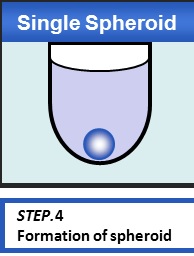Lipidure®-COAT Plates
Effective Tool for Spheroid Culture
Spheroid cell culture is typically based on the spontaneous formation of an aggregate of cells in an environment where cell-cell interactions dominate over cell-substrate interaction. This can be achieved by using low-attachment cell culture conditions.
Lipidure
®-COAT plates and dishes are a top of the range solution for spheroid formation, with the Lipidure
® coating providing a superior low-attachment solution for the formation of single spheroids in each well of multi-well plates. Using Lipidure-COAT dishes, it is possible to undertake large scale assays to provide sufficient materials for applications such as Western blotting or gene expression microarrays.
How Does Lipidure®-COAT Work?

- 1. Low-adhesion surface promotes cell aggregation & spheroid formation.
- 2. Uses MPC Polymer: a biocompatible polymer containing Phosphorylcholine (which is found in cell membranes).
- 3. Completely synthetic, containing no substances of biological origin.
Cell Types Tested
Spheroid formation using Lipidure
® has already been demonstrated for the following cell types: human ES, mouse ES, human iPS, mouse iPS, NIH3T3, pre-adipocytes, HepG2 and other cancer cell lines.
Formation of Single, Centrally Located Spheroid on U-Bottom Plate
Superior Spheroid Formation


A single spheroid is generated in the Lipidure®-COAT U-bottom well, while numerous satellite spheroids are found in the competitor’s plates. This phenomenon shows that a lot of cells adhered to the competitor’s “low-adhesion” surface.
Spheroid Formation and Application in Anti-Cancer Drug Tests Using Lipidure®-COAT

Hep G2 spheroids were formed for 5 days. Cell viability was determined by WST assay after further 2 days incubation with or without Mitomycin-C
Application Notes for Lipidure®-COAT Plates:
Product List:
Publications:










